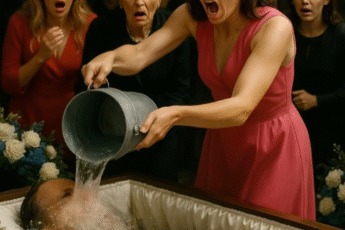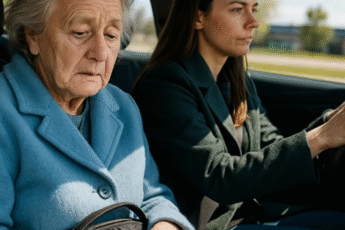For the past year, my life has been a ghost story. I live in a house haunted by the memory of my late wife, Seraphina. Her ghost is in the half-empty closet, in the lingering scent of the vanilla candle I can’t bring myself to throw away. But the most powerful ghost of all is the one I see every day in the face of our seven-year-old son, Theo. He has her eyes, that brilliant, startling shade of green, a heartbreakingly beautiful echo of a light I thought was extinguished forever.
I am trying my best to be both a mother and a father to him, a task for which I feel profoundly unqualified. Sera was the sun in our small, happy universe. Now, we are just two small planets, drifting in a quiet, empty darkness.
On this particular Saturday, a day of almost cruelly cheerful autumn sunshine, I had taken Theo to the park. It was a place teeming with our own ghosts; it was where Sera and I had our first date, where we’d married under the branches of a grand old oak tree. But it was also a place of life, a place for a small boy to run and climb and forget, for a little while, the quiet sadness of our home.
I was on a bench, watching him on the swings, when I saw her. A little girl, no older than Theo, with a wild mane of dark, curly hair, stood alone near the entrance to a wooded trail. She was crying, not with loud, theatrical sobs, but with the quiet, desperate tears of a child who is truly and completely lost. My heart, a numb, scarred-over muscle, ached for her.
I walked over, Theo trailing curiously behind me. “Hey there,” I said softly. “Are you lost?”
She looked up, her eyes a startlingly familiar shade of green, wide with fear. She just nodded, a single, perfect tear tracing a path through the dirt on her cheek. I spent the next twenty minutes in a state of focused purpose I hadn’t felt in a long time. I was no longer a grieving husband; I was a father, a protector.
Her name, she whispered, was Willow. She didn’t know her address or her parents’ phone number.
“It’s okay,” I soothed. “Do you remember anything about your house?”
She thought for a moment, her little brow furrowed, and then her face lit up with a single, clear memory. “My house is the one with the big purple lilac bush by the front door,” she said, her voice suddenly bright. “The one that smells like vanilla.”
The world stopped. The sound of children laughing, the distant traffic, the rustle of leaves—it all faded into a dull roar in my ears. The house with the lilacs that smelled like vanilla. It wasn’t just a description; it was a line from a story my own beautiful, lost Sera had told me a hundred times. It was her fairytale memory of the house she had grown up in, on the other side of town.
It was a coincidence. A strange, impossible, heartbreaking coincidence. My logical mind insisted on it. But in a life that had been so devoid of magic for so long, it was a coincidence I could not ignore.
“You know what, Willow?” I said, my voice filled with a strange, wild hope. “I think I might know just where that is.”
The drive across town was a journey into a part of my own heart I had kept locked away. As I drove, my mind was a war between logic and a desperate, foolish hope. You’re a grieving man seeing ghosts where there are none. In the back, the two children, now feeling safe, had begun a quiet conversation.
“How did you get separated from your mommy?” Theo asked.
“Our puppy, Daisy, saw a squirrel and ran away,” Willow explained. “Mommy told me to stay on the bench, but then a big band started playing and a crowd came and I couldn’t see her anymore.”
It was a simple, plausible story. Yet every innocent detail she shared seemed to echo with a strange familiarity. She told Theo she loved to draw, that her mommy said she had “her mother’s hands.” She spoke of her love for the color yellow, her hatred of broccoli, of the made-up songs she sang to her puppy. Each detail was a perfect, one-to-one match with my lost Sera.
I turned onto her old street, a quiet, tree-lined avenue I knew from a thousand family photographs. Before I could ask Willow if anything looked familiar, she leaned forward, her small hand pressing against the back of my seat.
“There it is!” she shrieked, bouncing with joyful recognition. “That’s my house! The one with the lilacs!”
I slammed on the brakes, my heart hammering against my ribs. It was the house. A beautiful two-story Victorian with a wraparound porch and a magnificent, ancient lilac bush in the front yard. It was the house where I had first met her parents, a house of my most cherished memories, a house I had been told was sold to strangers years ago.
I was not in a dream. I was about to knock on a door that would lead me directly into the heart of a ghost story. And I had a terrible and wonderful feeling that the ghost was about to answer.
I got out of the car, my legs unsteady. The children scrambled out and ran ahead, up the familiar stone pathway. The air was thick with the scent of lilacs, a sweet, heavy perfume that smelled impossibly of vanilla. Willow, in her excitement, pressed the doorbell. A cheerful, familiar chime echoed from a life I thought was long gone.
The door opened.
And the world stopped.
It wasn’t a woman who looked like my wife. It was her. It was Sera. Standing in the doorway, a look of warm, maternal concern on her face. The same green eyes. The same smile. The same small, curious tilt of her head. Her hair was shorter, a chic bob instead of the long waves I had loved, but it was her. An impossible, beautiful, and deeply cruel miracle.
“Mommy!” Willow cried, throwing her arms around the woman’s legs.
Then my own son, Theo, who had been clutching my hand, let go. He looked at the woman’s face, the face he had only known from photographs, and with the simple, heartbreaking logic of a seven-year-old who has just been presented with a miracle, he let out a cry of his own.
“Mommy,” he whispered, and he too ran forward, clinging to the strange woman’s other leg.
The woman in the doorway, the ghost of my wife, was now in a state of equal, total shock. She looked down at her daughter, then at the strange, beautiful little boy who was also calling her mommy. Then her gaze, her beautiful, familiar, and deeply confused green eyes, lifted and met mine.
“Sarah,” I finally managed to whisper, the name a ghost on my own lips.
She looked at me, and her eyes filled with a new, dawning, and terrible pity. “I don’t know who Sarah is,” she said, her voice a soft, gentle thing that was both a comfort and a torture. “My name is Rosalind.” She looked from my stunned face to my weeping son. “Please,” she said, her voice a quiet invitation. “Come inside. I think… I think we have a great deal to talk about.”
We sat in her sunlit living room, two strangers bound by an impossible reflection. The two children, now quiet, stared at each other from opposite ends of the sofa, two identical puzzle pieces from two different boxes. We began the slow, painful work of trying to assemble that puzzle.
I told her my story, my voice thick with a grief that was now utterly confounded. With a trembling hand, I pulled the worn photograph from my wallet—me and my Sera on our wedding day. She took it, and her own hand began to shake. She stared at her own face, at her own smile, at a life she had never lived.
Then, she told me her story. She had been adopted as a baby, raised as an only child by a loving couple who had passed away years ago. She had never known her birth parents. She had never had any reason to believe she was not completely alone in the world.
We were not crazy. We were not dreaming. We were two halves of a single, tragic, long-buried story. My beautiful, lost Sera had an identical twin.
“We have to know the truth,” Rosalind said, her voice now full of a fierce, powerful resolve.
Our search began. We hit a wall of bureaucratic red tape; their adoption records were sealed. Weeks of digging through dusty city archives yielded nothing. The trail was cold. Then, I remembered the box.
It was a memory from a long-ago conversation with Sera, a detail buried under the weight of my grief. On her eighteenth birthday, her adoptive mother had given her a small, hand-carved wooden box. “It contains the truth of where you came from,” her mother had told her. But Sera, content in the love of her new family, had never opened it. The past, she’d told me, felt too painful to look at.
The box was still in my attic, a dusty, forgotten relic. I looked at Rosalind, at my late wife’s face, and felt a surge of terrifying hope. The legal system had sealed their past, but a mother’s love, her need to tell her daughter the truth—that was a thing that could not be so easily erased.
I carried the small, simple box down from the attic as if it were a sacred, explosive relic. We sat together on my living room floor, the children now playing quietly with a set of building blocks, a small, beautiful island of a new, innocent family.
I opened the box. Inside, on a bed of faded blue velvet, lay a tiny pair of knitted, pale-yellow baby booties. Rosalind let out a small, choked sob. Beneath them were two small, plastic hospital bracelets. One read Baby Girl A. The other, Baby Girl B. At the very bottom was a single, folded photograph.
I picked it up with a reverence I didn’t know I possessed. I unfolded it. Two babies. Two tiny, perfect, and absolutely identical newborn girls, wrapped in pink and blue striped hospital blankets, lying side-by-side in a single bassinet.
With a shaking hand, I turned the photograph over. An inscription, in the elegant, faded handwriting of Sera’s adoptive mother:
My dearest Seraphina, and her sister, Rosalind. August 14th, 1995. They told me it was for the best that you were separated. They told me it would be less confusing if you never knew. I have never believed them. A heart should never be split in two. I pray that one day, somehow, the universe will bring you back to each other.
The search was over. The ghost had a name. The puzzle was complete. The impossible, beautiful, and unthinkable truth was real. And now, the much harder, much more beautiful work of piecing together two families and two lifetimes into one was just about to begin.
The weeks that followed were a quiet, strange, and deeply beautiful process of discovery. Our two separate families began to slowly, cautiously merge. Rosalind and Willow became a constant, welcome presence in my quiet, sad house, and Theo and I found a new, second home in her beautiful house with the lilacs.
We did not just build a new future; we began the slow, often painful work of piecing together a shared past. Rosalind would spend hours looking through my old photo albums, tracing the lines of her own face in my wife’s, a look of profound wonder in her eyes. “She had my smile,” she would whisper.
And our children, our two beautiful, resilient children, were the true, undeniable proof of the miracle. Theo and Willow, who were not just cousins but, as we learned, genetic half-siblings who shared the DNA of two identical mothers, became inseparable. The world saw them as brother and sister. And in a way, they were. Two halves of a single, beautiful story, finally and completely brought together.
It has been a year. I am standing in a sun-drenched garden, the air thick with the sweet, familiar scent of lilacs that smell of vanilla. It is the garden of the house with the lilacs, a house that is no longer just Rosalind’s, but ours. Rosalind has planted a new, second lilac bush beside the ancient one. “So they can finally grow together,” she’d told me.
I watch as my son and my new niece chase each other through the grass, their joyful shrieks a beautiful, healing music. The profound ache of Sera’s absence will never truly go away, but it is not a lonely ache anymore. It is a grief that is now shared, a memory that is now a living, breathing part of this new, beautiful family we have all built together from the wreckage of the past. The universe, in its own strange, mysterious way, had not given me my wife back. It had given me the next best thing. It had given me the other half of her heart.




